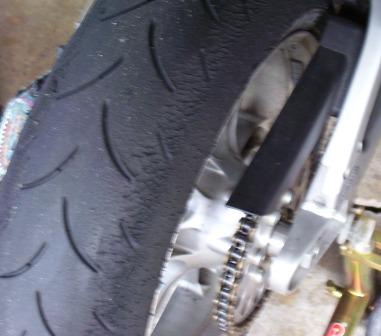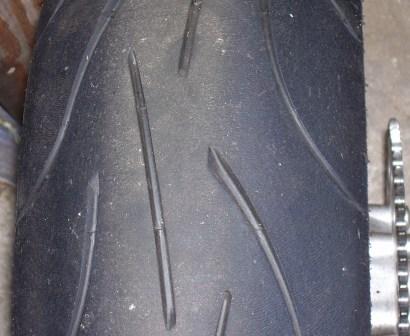| Author | Message | ||
Knickers |
At my final track day this year I switched from Pilot Powers to Pilot Race (PR1/PR4) tires. I guess I shouldn't be surprised that they wear quicker, but the tearing and shredding of the rubber seems atypical compared to what I see on other bikes using these tires. This is what I'd expect a liter bike would do, rather than a little xb9r.  I spoke with the tire guy at the track and his opinion was I was transferring too much weight to the rear exiting corners and more rear compression would help. Well, with compression maxed out (stock shock) I saw no better results. (This was running a 1:34 pace at Grattan, I was told 1:32 is a decent pace by an SV650 racer) His next comment was "Ohlins". Before I go dropping that kind of coin it would help to know if it has the potential to keep my tire bill in check. Here's what my Pilot Power looks like after 5 track days.  I did switch shocks at the same time I switched tires. The one on the bike had a much heavier spring - so much that I couldn't get 25mm sag out of it at min preload. Strange because I weigh 190 and the racer I bought the bike from was about 160lb. Anyway this shock was blown and had no rebound damping so I changed back to stock. So I've made the mistake of changing two things at once, but I'm not keen to go back to a too stiff spring to see if my wear situation improves. So if I step up to racing next year should I budget for the bling shock, more tires, or both. Ok, I think I know the answer to that one - I just need someone else to tell me. Kurt Oh, I guess I should say something about tire pressure - I was running at 26 psi cold in the PR4 vs. 30 cold in the Pilot Power. The Michelin guy had recommended 24-26 cold so I wasn't keen to run more than the high end of the recommendation. (Message edited by knickers on September 30, 2007) (Message edited by knickers on September 30, 2007) | ||
Schmitty |
What was your rear preload set at? I would say the same thing the tire guy said. If you can't get any more compression you'll have to try to use the preload setting to compensate. Those look like my Bridgestones before I stiffened up the rear end. The stock shock can do a pretty good job for a guy running an amateur pace, but once you step yourself up to the next level you're going to need a better shock. Schmitty | ||
Rsh |
Maybe this will point you in the right direction. http://www.feelthetrack.com/tire-wear.html | ||
Knickers |
Thanks for the link. I guess I'm going to have to monitor my cold to hot tire pressures a little closer and try more preload (currently set at 30mm). That photo of shock rebound tear looks just like my 2CT rear that I ran with the shock with no rebound with the leading edge of each tread worn to nothing. Interesting. | ||
Trojan |
It looks like you are suffering from 'cold tearing' of your tyre. Rather than suspension seting this is more likely to be caused by running at the wrong tyre pressures. I'm not sure about the Michelin recommended pressures for these tyres in track use, but typical supersport spec track tyre pressure would be 32/34 psi F/R. 24/26 seems very low to me. | ||
Slaughter |
Some of the new Michelin run really crazy pressures. I'll go see what they're using... be right back but Wot Trojan sed... looking like cold/soft tearing. | ||
Slaughter |
31 front, 22 rear (yes, you read right - those are RECOMMENDED pressures) on cold tires with that combination of Michelin Pilot Race. Out here the Michelin guy is Dale Kieffer at Racer's Edge. He's great on advice and sells primarily to racers and track day fans and knows his stuff. Shoot him an email, attach the pics (or link to them) with ALL conditions you can give him (cold pressures, track temps, air temps, etc). racersedge1@earthlink.net Or call: 702-257-3808 | ||
Xb9 |
looks to me to be too much air pressure the way it's worn. If overinflated the contact patch is smaller and all the load is concentrated on a smaller area of the tire - hence the tearing. the Pilot race uses a totally different carcass and like Slaughter said 22 lbs. cold on the rear. Also, keep in mind that your cold tire pressure is different at 8 or 9 am vs 2pm, especially in the Northern climates this time of year. I usually end up letting out a little air as the day heats up to maintain that "cold" tire pressure. | ||
Knickers |
Wow, 22 psi? Cold tearing makes sense then since I was at 26 psi. When I was told to use 24 to 26 cold I thought I should go with 26 being that running an amateur pace I wouldn't be getting them as hot, therefore I'd need the additional cold pressure to get the proper hot pressure. The more I think about it, that must be backwards. I probably need a lower cold temperature so I can get more heat into the tire at the slower pace and end up at the same operating temperature. I suppose I need to be targeting a cold to hot pressure delta as that should correlate to the tires hot operating temperature. PV=nRT and all that. Lots to learn, lots to learn. Thanks for the contact Steve, I'll be getting in touch with Dale. | ||
Slaughter |
The first time I heard the pressures, I was surprised but yes, those numbers ARE real. You are absolutely correct - the lower pressures work the tire carcass more, increasing the heat generated. Obviously you can't just keep dropping the pressures - those numbers are arrived at by the experience of the development guys and the racers themselves. Those recommended pressures are for track/racing. I would bet that the recommended "street" pressures are 4-6 pounds higher... at least that is typical of Pirelli. Again, unless a dealer is racing, they're not going to be able to help you with pressures since they're at the mercy of the "Factory" recommendations. Those recommended pressures are based on tire life and NOT traction and handling. You will get about a fourth (or less) of the miles out of a set of tires set for proper pressure on the track compared to the higher "street" pressures. Dale Kieffer is a really great guy, he's a racer AND he sells Michelins. He will also ship - but he can recommend a more local Michelin guy you can hit at your racetrack if that works better for you. (Message edited by slaughter on October 02, 2007) | ||
Mtg |
Mythbusters, suspension style: Increasing rear rebound damping does NOT decrease weight transfer to the rear of the bike. Weight transfer is dictated by Cg position and wheelbase only, with acceleration as the input. This is basic statics. Adjusting damping as a means of changing the handling only affects how FAST the load transfers, not how MUCH load transfers. If you increase rear compression damping, you make the load transfer onto the rear wheel happen FASTER as you roll on the throttle coming out of the corner. Increasing rear rebound would be a solution if you had the problem of spinning the rear as SOON as you got on the throttle- assuming you aren't "over the hump" of the tire curve. |